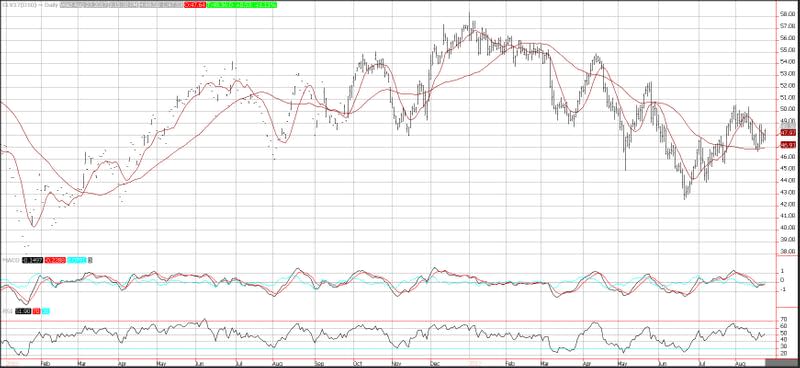Crude Oil Price Analysis for August 24, 2017
Crude oil prices were higher on Wednesday, following a larger than expected draw in crude oil inventories. Gasoline stocks also declined more than expected, and distillates inventories were unchanged compared to expectations that they would increase. Imports increased for the second consecutive week, despite OPEC’s attempt to reduce global oil stockpiles. U.S. domestic production increased according to the EIA, climbing by 26K barrels in the latest week.
Technicals
Crude oil prices rallied 1.1%, on the back of the larger than expected draw in crude oil inventories. Prices were able to recapture the 10-day moving average which is seen as short term support near 47.97. Additional support is seen near the 50-day moving average at 46.91. Resistance on crude oil prices is seen near the August highs at 50.43. Short term momentum has turned positive as the MACD (moving average convergence divergence) index generated a crossover buy signal. This occurs as the spread (the 5-day moving average minus the 13-day moving average) crosses above the 6-day moving average of the spread. The index moved from negative to positive territory confirming the buy signal. The MACD histogram is printing in the black with an upward sloping trajectory which points to higher crude oil prices.

Refinery Output declined
U.S. crude oil refinery inputs averaged about 17.5 million barrels per day during the week ending August 18, 2017, 104,000 barrels per day less than the previous week’s average. Refineries operated at 95.4% of their operable capacity last week. Gasoline production increased last week, averaging about 10.6 million barrels per day. Distillate fuel production decreased last week, averaging 5.1 million barrels per day.
Imports Increased
The Department of Energy reported that U.S. crude oil imports averaged 8.8 million barrels per day last week, up by 664,000 barrels per day from the previous week. This comes despite OPECs attempt to reduce global stockpiles. Over the last month, crude oil imports averaged over 8.2 million barrels per day, 3.1% below the same month last year.
Inventories Declined More than Expected
Inventories continue to move lower which does show that OPECs output reduction is having some effect. The Energy Information Administration reported that U.S. commercial crude oil inventories decreased by 3.3 million barrels from the previous week. Gasoline inventories decreased by 1.2 million barrels last week, while distillate fuel inventories remained unchanged last week. Total commercial petroleum inventories remained unchanged last week. This latest EIA report marks the eighth straight week of crude oil inventory declines. Production remained relatively flat on the week, at 9.5 million barrels per day, giving further cause for optimism, at least temporarily.
Demand Remains Robust
Demand for distillates remains robust. The EIA reported that total products demand over the last month averaged over 21.0 million barrels per day, up by 1.4% from the same period last year. Over the last month, gasoline demand averaged 9.7 million barrels per day, down by 0.4% from the same period last year. Distillate fuel demand averaged over 4.2 million barrels per day over the last month, up by 14.4% from the same month last year.
The API Reported a Draw
The American Petroleum Institute reported that U.S. crude oil inventories declined by3.595 million barrels in the latest week which was more than expected. Cushing Oklahoma inventories, where WTI crude oil is priced, were also down 462,000 barrels, for the week ended August 18. Gasoline inventories rose climbing 1.402 million barrels, while distillates were up 2.048 million barrels.
Japans Economic is Getting Stronger
Japan flash August manufacturing PMI rose to 3-mth high of 52.8, up from 52.1. The index also remained above the 50 which designates expansion for the 12th consecutive month and rose to the highest since May. The preliminary index for new orders rose to 52.7 from a final 51.8 in July. If confirmed, that would mark a three-month high. The index for new export orders rose to 52.2 from 50.9 in the previous month. This comes on the heels of a better than expected Q2 GDP report, which shows that the world’s this largest economic is continuing to expand.
Europe’s Economic is getting Stronger
Eurozone preliminary August PMI unexpectedly improved in the composite number. Individual readings were mixed, but the unexpected rise in the manufacturing reading to 57.4 from 56.6, still helped to compensate for the dip in the services reading to 54.9 from 55.4 and left the composite at 55.8, up from 55.7 in the previous month. Expectations had been for a steady to lower number. The ECB has already acknowledged that the recovery is strengthening, but remains firmly focused on still weak inflation and wage growth, arguing that the recovery still needs substantial monetary support.
This article was originally posted on FX Empire
